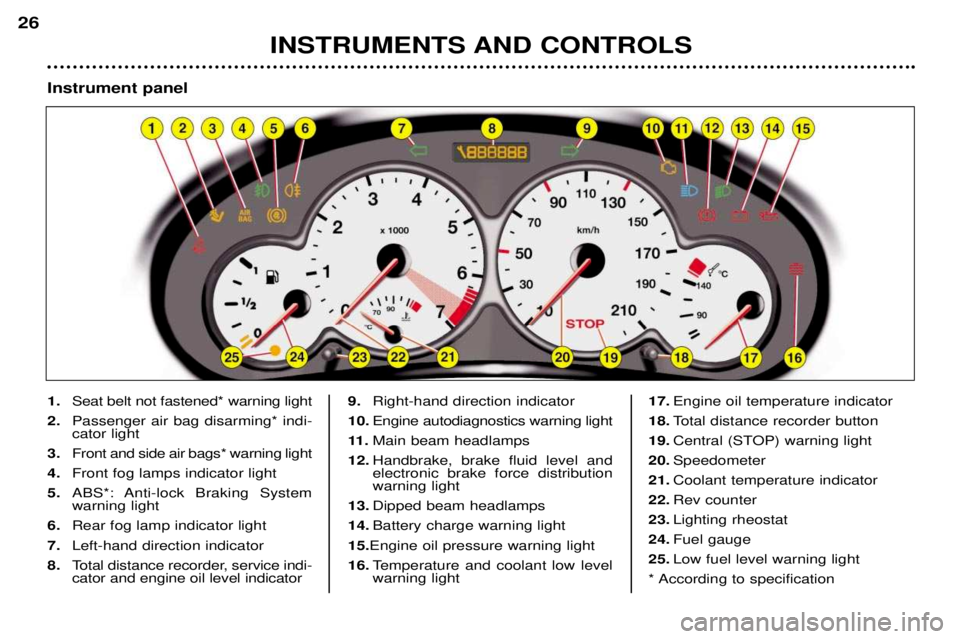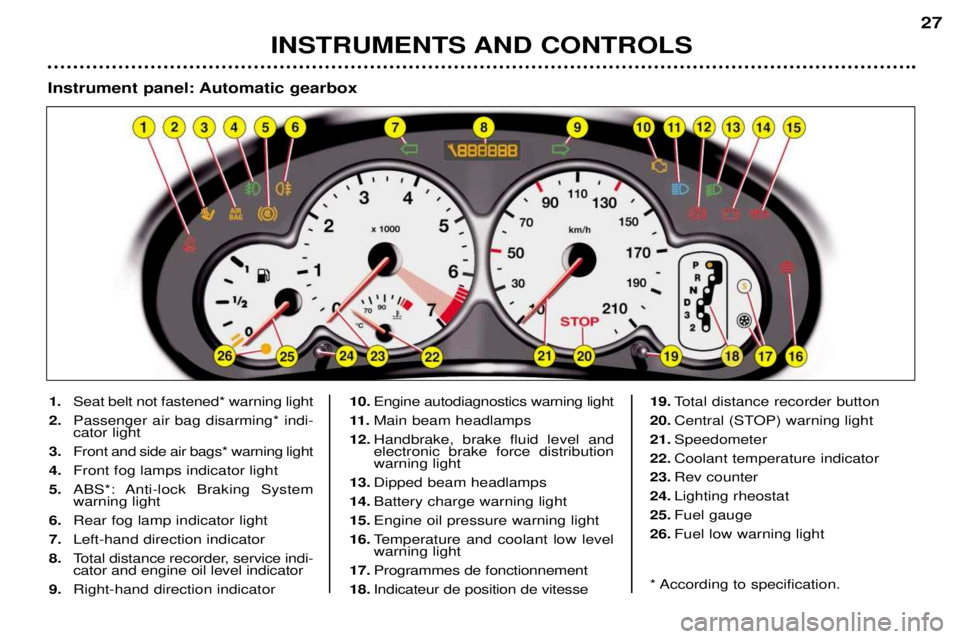Page 2 of 123
1Bonnet opening control
2 Fuse box
3 Storage
4 Steering wheel height adjust- ment control
5 Headlamp height adjustment
6 Lights and fog lamps stalk
7 Adjustable side vent
8 Heated seats switch*
9 Side windows demisting vents
10 Passenger air bag disarmingswitch*
11 Driver's air bag / horn
12 Instrument panel lighting rheostat
13 Windscreen wash/wipe stalk 14
Radio steering column stalk
15 Steering lock
16 Central adjustable vents
17 Hazard warning lights switch
18 Multifunction display
19 Audio equipment
20 Windscreen demisting vents
21 Passenger air bag
22 Glove box
23 Controls for heating, ventila-tion, air conditioning and rearscreen and mirrors demisting
24 Front ashtray
25 Gear lever
26 Lighter
27 Electric mirrors switch 28
Electric windows switch
29 Handbrake
30 Retractable roof switch
* According to specification.
3YOUR AT A GLANCE
Page 3 of 123

7YOUR AT A GLANCE
STARTING The four positions of the key in the ignition:
STOP position:the ignition is
off.
1st notch, Accessories posi- tion: the ignition is off but the
accessories can be used. 2nd notch, Running position: the ignition is on. Starting position : operates the
starter. Steering lock Before starting, unlock the steer-
ing if necessary, by gently tur-ning the steering wheel at the
same time as you turn the key. It is advisable to press the clutch pedal while operating the starter
to make starting easier. Starting a petrol engin
Do not press the accelerator.
Operate the starter, without
releasing the key, until the engineturns.
THE KEYS The keys operate
independently
the locks for the boot (opening), the fuel filler flap, the steeringlock, the glove box and the pas-senger air bag disarming switch. Central locking
From the driverÕs door, the keys allow you to:
Ð simultaneously lock the doors and the boot,
Ð simultaneously unlock just the doors.
You can only unlock the boot by using the lock. The remote control Pressing button A
allows you to lock the doors and boot. This is displayed by the continuous light-ing of the directionindicators forapproximately twoseconds. Pressing button Ballows you to
unlock the doors only.This is indicated by the quick flashing of the direc-tion indicators for approxi-mately two seconds. * According to country.
68
Never race a cold engine.
Never run the engine in anenclosed space. Do not make any modications to the steering lock.
Page 4 of 123

4THE ELECTRIC
RETRACTABLE ROOF Opening the roof� Ensure that the screen 1is
hooked on (nothing must be placed on the screen; if thereis luggage in the boot, it mustnot cause the screen to lift up).
� Check that there are noobjects on the rear shelf.
� When stationary , with the
handbrake applied, turn theignition key to position M.
� Completely release the two
hooks 2; this operation is vali-
dated by an audible signal.
� Press button 3until you hear a
signal to indicate that the roofclosing operation is complete.
Note: during this operation the
windows open. Closing the roof �
When stationary, with the
handbrake applied, turn the ignition key to position M.
� Press button 3until you hear a
signal to indicate that the roofclosing operation is complete.
� Lock the two hooks 2.
Note: the window control switches
become operational again after theroof manoeuvre.YOUR AT A GLANCE
72
The roof must not be operated when a loa-ded luggage carrier isfitted on the boot lid.
During roof opening or clos-ing operations, to avoid risk of
injury, ensure that no-one is inthe proximity of the movingparts.
If there is any danger, release the control switch;the operation will stop
instantly. Never release button 3 for any length of time, or
switch off the ignition,when the roof is in an inter-mediate position (neithercompletely open or closed).
Page 6 of 123

ELECTRONIC IMMOBILISER This locks the engine manage- ment system a few momentsafter the ignition has been
switched off and therefore pre-vents starting of the vehicle byanyone who does not have the
key. Operation Each key has an electronic chip, which has a special code. When the ignition is switched on, the key code is recognised andstarting is possible. If the key does not have a code
or has a different code from that
stored in the system memory, thevehicle will not start. Additional key
You can store up to 5 keys in the
memory.If you require an additional key or
wish to change a faulty key, you
must visit a PEUGEOT dealerwith the confidential card and allthe keys in your possession. Key in ignition If you leave the key in the igni- tion, this is indicated by a buzzer
upon opening the driverÕs door.
Confidential card This contains the identification code, which is required if anywork is carried out on the system
by a PEUGEOT dealer. Thiscode is concealed by a film,which must not be removedunless required. Keep your card in a safe place, never in your vehicle.
6YOUR AT
A GLANCE
When buying a second-hand car: ¥ ensure that you are given the confidential card;
¥ it is advisable to have the key codes memorised by a
PEUGEOT dealer to ensure that the keys in your possession are the only ones which can start the vehice.
Do not make any modifications to the PEUGEOT electronic engineimmobiliser system.
69
Page 9 of 123
9YOUR AT A GLANCE
STEERING WHEEL HEIGHT Lower the control to release the steering wheel. Adjust to the required height and raise the control to lock the steer-ing wheel. OPENING THE BONNET Inside the vehicle:
pull the handle.
Outside the vehicle: lift the
catch and lift the bonnet. Secure the strut to hold the bonnet open.
8271
Page 10 of 123

11YOUR AT A GLANCE
FRONT AIR BAGS Disarming the passenger air bag Insert the ignition key into switch 1 and turn it to:
Ð the passenger air bag ONposi-
tion,
Ð the passenger air bag OFF
position.
Operating check
With the ignition on (2nd notch onthe key), switching on of thiswarning light, accompanied by anaudible signal and the message*''Passenger air bag disarmed''on the multifunction screen, indi-cates that the passenger air bag
is switched off ( ''OFF''position
on the switch). The warning light remains switched on throughout the dura-tion of the disarming process. Precautions concerning the passenger air bag
Vehicle fitted with a passenger air bag disarming switch:
Ð disarm the air
bag if you install a rearwards-fac-ing child seat
Ð arm the air bag when you trans-port an adult.
Vehicle not fitted with a passen-ger air bag disarming switch:
Ð do not install a rear-facing child seat on the frontpassenger seat.
Never place your feet or anyobject on the instrument panel. "ISOFIX" MOUNTINGS
Available on the front passenger seat, Isofix mountings allow fit-ting of a
special child seat , sold
by PEUGEOT dealers. The locks incorporated in the child seat fit onto the "Isofix"mountings, ensuring reliable,
safe and fast assembly. The childseat must be fitted in the rear-facing position for children weigh-ing less than 29 lbs or 13 kg (to
do this it is essential to disarmthe passenger air bag) .
Follow the instructions for fittingthe child seat in the manufactur-er's installation brochure.
8864
Page 22 of 123

INSTRUMENTS AND CONTROLS
26
1.Seat belt not fastened* warning light
2. Passenger air bag disarming* indi- cator light
3. Front and side air bags* warning light
4. Front fog lamps indicator light
5. ABS*: Anti-lock Braking Systemwarning light
6. Rear fog lamp indicator light
7. Left-hand direction indicator
8. Total distance recorder, service indi-cator and engine oil level indicator 9.
Right-hand direction indicator
10. Engine autodiagnostics warning light
11 . Main beam headlamps
12. Handbrake, brake fluid level andelectronic brake force distributionwarning light
13. Dipped beam headlamps
14. Battery charge warning light
15. Engine oil pressure warning light
16. Temperature and coolant low levelwarning light 17.
Engine oil temperature indicator
18. Total distance recorder button
19. Central (STOP) warning light
20. Speedometer
21. Coolant temperature indicator
22. Rev counter
23. Lighting rheostat
24. Fuel gauge
25. Low fuel level warning light
* According to specification
Instrument panel
Page 23 of 123

INSTRUMENTS AND CONTROLS27
1. Seat belt not fastened* warning light
2. Passenger air bag disarming* indi- cator light
3. Front and side air bags* warning light
4. Front fog lamps indicator light
5. ABS*: Anti-lock Braking Systemwarning light
6. Rear fog lamp indicator light
7. Left-hand direction indicator
8. Total distance recorder, service indi-cator and engine oil level indicator
9. Right-hand direction indicator 10.
Engine autodiagnostics warning light
11 . Main beam headlamps
12. Handbrake, brake fluid level andelectronic brake force distributionwarning light
13. Dipped beam headlamps
14. Battery charge warning light
15. Engine oil pressure warning light
16. Temperature and coolant low levelwarning light
17. Programmes de fonctionnement
18. Indicateur de position de vitesse 19.
Total distance recorder button
20. Central (STOP) warning light
21. Speedometer
22. Coolant temperature indicator
23. Rev counter
24. Lighting rheostat
25. Fuel gauge
26. Fuel low warning light
* According to specification.
Instrument panel: Automatic gearbox